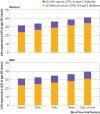Healthy lifestyle and life expectancy free of cancer, cardiovascular disease, and type 2 diabetes: prospective cohort study
- PMID: 31915124
- PMCID: PMC7190036
- DOI: 10.1136/bmj.l6669
Healthy lifestyle and life expectancy free of cancer, cardiovascular disease, and type 2 diabetes: prospective cohort study
Abstract
Objective: To examine how a healthy lifestyle is related to life expectancy that is free from major chronic diseases.
Design: Prospective cohort study.
Setting and participants: The Nurses' Health Study (1980-2014; n=73 196) and the Health Professionals Follow-Up Study (1986-2014; n=38 366).
Main exposures: Five low risk lifestyle factors: never smoking, body mass index 18.5-24.9, moderate to vigorous physical activity (≥30 minutes/day), moderate alcohol intake (women: 5-15 g/day; men 5-30 g/day), and a higher diet quality score (upper 40%).
Main outcome: Life expectancy free of diabetes, cardiovascular diseases, and cancer.
Results: The life expectancy free of diabetes, cardiovascular diseases, and cancer at age 50 was 23.7 years (95% confidence interval 22.6 to 24.7) for women who adopted no low risk lifestyle factors, in contrast to 34.4 years (33.1 to 35.5) for women who adopted four or five low risk factors. At age 50, the life expectancy free of any of these chronic diseases was 23.5 (22.3 to 24.7) years among men who adopted no low risk lifestyle factors and 31.1 (29.5 to 32.5) years in men who adopted four or five low risk lifestyle factors. For current male smokers who smoked heavily (≥15 cigarettes/day) or obese men and women (body mass index ≥30), their disease-free life expectancies accounted for the lowest proportion (≤75%) of total life expectancy at age 50.
Conclusion: Adherence to a healthy lifestyle at mid-life is associated with a longer life expectancy free of major chronic diseases.
Published by the BMJ Publishing Group Limited. For permission to use (where not already granted under a licence) please go to http://group.bmj.com/group/rights-licensing/permissions.
Conflict of interest statement
Competing interests: All authors have completed the ICMJE uniform disclosure form at www.icmje.org/coi_disclosure.pdf (available on request from the corresponding author) and declare: support from the National Institutes of Health; YL has receiving research support from the California Walnut Commission; AP has received research support from BY-HEALTH outside of the submitted work; FBH has received research support from the California Walnut Commission, and honorariums for lectures from Metagenics and Standard Process, and honorariums from Diet Quality Photo Navigation, outside the submitted work; no other relationships or activities that could appear to have influenced the submitted work.
Figures


Comment in
-
We shouldn't recommend harmful foods "in moderation".BMJ. 2020 Feb 3;368:m365. doi: 10.1136/bmj.m365. BMJ. 2020. PMID: 32014886 No abstract available.
-
Healthy lifestyle and life expectancy: fund prevention programmes to end the cycle of preventable morbidity.BMJ. 2020 Feb 4;368:m427. doi: 10.1136/bmj.m427. BMJ. 2020. PMID: 32019741 No abstract available.
-
Improving nutrition in India: encouraging informed food choices.BMJ. 2020 Feb 10;368:m367. doi: 10.1136/bmj.m367. BMJ. 2020. PMID: 32041694 No abstract available.
References
-
- GBD 2015 DALYs and HALE Collaborators Global, regional, and national disability-adjusted life-years (DALYs) for 315 diseases and injuries and healthy life expectancy (HALE), 1990-2015: a systematic analysis for the Global Burden of Disease Study 2015. Lancet 2016;388:1603-58. 10.1016/S0140-6736(16)31460-X - DOI - PMC - PubMed
